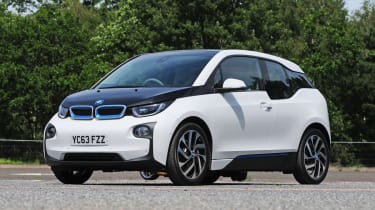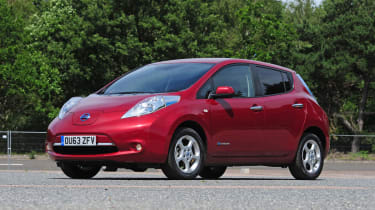BMW i3 vs Nissan Leaf
Battery-powered BMW i3 goes head-to-head with the Nissan Leaf in hi-tech electric car shoot-out
The buzz surrounding electric cars is increasing all the time. More new models than ever are being launched, while lots of brave buyers are taking the plunge. So it’s no surprise that BMW has jumped on the eco-friendly bandwagon with its bold i3 hatchback.
We’ve already been impressed by the petrol-electric range-extending version, so expectations are high for the all-electric model. Boasting the same advanced carbon fibre-reinforced plastic structure, jaw-dropping looks and cleverly packaged interior as the range extender, the i3 promises to revolutionise the electric car class. It also aims to deliver typical BMW driving thrills, thanks to its punchy 168bhp electric motor, low kerbweight and rear-wheel-drive layout.
Once you factor in the Government’s £5,000 Plug-in Car grant, the newcomer will set you back £25,680, which is only a couple of hundred pounds more than a top-of-the-range Nissan Leaf.
The Leaf was one of the first credible electric cars to hit UK roads, and with its combination of family friendly practicality, decent range and assured driving dynamics, it still sets the benchmark for the class.
So which of our eco-friendly contenders will take the winner’s crown in this highly charged encounter?
Click on the links above to read each review, then read on for our verdict.
Head-to-head

Charging
Both cars feature illuminated charging sockets, helping to take the strain out of plugging in at night, plus they can be charged to 80 per cent capacity in between seven and eight hours when using a standard household socket.
Used - available now

2024 BMW
M3
29,000 milesAutomaticPetrol3.0L
Cash £49,850
2025 BMW
iX
81,249 milesAutomaticElectric
Cash £26,272
2022 BMW
i3
33,096 milesAutomaticElectric
Cash £14,032
2025 Toyota
Yaris Hybrid
26,859 milesAutomaticPetrol1.5L
Cash £14,935However, if you’ve got an off-road parking space, then a powerful wall-mounted charger will be a better bet. Nissan uses the free British Gas unit, but you’ll pay £315 for BMW’s i Wallbox.
Space race
The BMW has the upper hand when it comes to interior room. Its neat pillarless door opening makes for easy access to the back seat – although the wide, carbon fibre door sill will be a hurdle for some. Light materials and large windows also help make the i3’s cabin feel brighter and more airy than its rival’s more traditional interior.
Residuals
Mainstream manufacturers are embracing electric cars, but the used trade is less convinced about their long-term appeal. Our experts predict the BMW will hold on to just 30.8 per cent of its value after three years, while the Nissan will retain a woeful 26 per cent.
Verdict
1st place: BMW i3

It’s hard not to be swayed by the BMW’s eye-catching looks and cleverly designed cabin. Yet look beyond the car’s arresting visuals and you’ll find an electric car packed with innovative engineering that’s sure to filter down to more mainstream models. The i3 is also fast, comfortable and practical, while electric range is long enough for most short commutes. The only black mark is reserved for its disappointing handling.
2nd Nissan Leaf

As an eco-friendly family car that’s used for short, inner city journeys, the Leaf makes lots of sense – particularly in attractively priced entry-level guise. It’s also decent to drive, roomy and well equipped, while refinement and comfort are on a par with the BMW. Yet its styling and cabin aren’t up to the same standard, plus it’s not as quick. More importantly, the novel i3 makes the Nissan feel a little dated.
Figures
| BMW i3 | Nissan Leaf Tekna | |
| On-the-road price/total as tested | £25,680/£32,285 | £25,490/£25,490 |
| Residual value (after 3yrs/30,000) | £7,909/30.8% | £6,806/26.7% |
| Depreciation | £17,771 | £18,684 |
| Annual tax liability std/higher rate | £0/£0 | £0/£0 |
| Ins. group/quote/road tax band/cost | 21/£332/A/£0 | 25/£337/A/£0 |
| Cost of 1st/2nd/3rd service | £375 (5yr/60k miles) | £106/£171/£163 |
| Length/wheelbase | 3,999/2,570mm | 4,445/2,700mm |
| Height/width | 1,578/1,775mm | 1,545/1,770mm |
| Engine | AC electric motor | AC electric motor |
| Peak power | 168/4,800 bhp/rpm | 108/3,008 bhp/rpm |
| Peak torque | 250/0 Nm/rpm | 254/0 Nm/rpm |
| Transmission | Single speed/fwd | Single speed/fwd |
| Fuel tank capacity/spare wheel | Sealant | Sealant |
| Boot capacity (seats up/down) | 260/1,100 litres | 355/705 litres |
| Kerbweight/payload/towing weight | 1,270/425kg/N/A | 1,512/482kg/N/A |
| Turning circle/drag coefficient | 9.9 metres/0.29Cd | 10.4 metres/0.29Cd |
| Basic warranty (miles)/recovery | 3yrs (unltd)/3yrs | 5yrs (60,000)/3yrs |
| Service intervals/UK dealers | Variable/153 | 18k miles (1yr)/26 |
| Driver Power manufacturer/dealer pos. | 10th/24th* | 22nd/11th* |
| Euro NCAP: Adult/child/ped./stars | 86/81/57/4 | 89/83/65/5 |
| 0-60/30-70mph | 7.1/6.5 secs | 10.3/10.9 secs |
| 30-50mph | 2.3 secs | 3.9 secs |
| 50-70mph | 4.2 secs | 7.0 secs |
| Top speed | 93mph | 89mph |
| Braking 70-0/60-0/30-0mph | 49.5/38.1/8.7m | 52.0/36.6/9.6m |
| Claimed range | 120 miles | 124 miles |
| 80 per cent charge domestic socket | Seven hours | Eight hours |
| 80 per cent charge 50kW fast charger | 30 minutes | 30 minutes |
| Tailpipe CO2 emissions/tax bracket | 0g/km/0% | 0g/km/0% |
| Airbags/Isofix/park sensors/camera | Six/yes/£790^ | Six/yes/yes/yes |
| Air-conditioning/leather/heated seats | Yes/£2,000/£260 | Yes/yes/yes |
| Automatic box/stability/cruise control | Yes/yes/yes | Yes/yes/yes |
| Metallic paint/LED lights/keyless go | £530/£710/£330 | £525/yes/no |
| Sat-nav/USB/DAB radio/Bluetooth | Yes/yes/yes/yes | Yes/yes/no/yes |








